|
2007 Toyota FJ Cruiser Test Drive
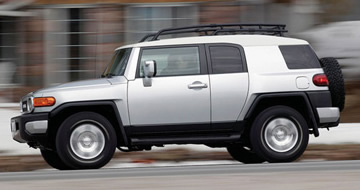 The past few years have seen more than one manufacturer bring vehicles out that have surprised the consumer. Retro is in but that doesn’t mean instant hit – think the Ford Thunderbird that disappeared after three years and the Pontiac GTO that is now gone. Just resurrecting a name doesn’t wash if the vehicle doesn’t fit current lifestyles and live up to it’s badging. So does the FJ Cruiser live up to it’s nameplate – we think it does.
Written/Photography by Albert V
Legendary is a word that aptly describes the Toyota Land Cruiser. While not the oldest of the down-sized 4x4 brands, it is probably the most recognized worldwide. The Land Cruiser started life in 1951 as the BJ, though mass production of this model didn’t start until 1953. The BJ enjoyed a solid five-year run through the ‘50s. Its replacement in 1958 is the vehicle we’re all familiar with – the FJ Series, starting with the FJ 25. The venerable FJ40 is certainly one of the most long-lived designs of the Toyota 4x4 brand in its history, running for over 25 years. It is interesting to see the historical demand for the Land Cruiser brand. It took from 1958 to 1980 to sell the first 1 million Land Cruisers (22 years). In the span of the next 10 years they sold another 1 million Land Cruisers. Then from 1990 to 2003, a span of only 13 years, Toyota sold 2 million additional Land Cruisers! This matches the previous 32 years of production.
It’s no wonder then that Toyota would like to parlay its experience and tradition to come up with a truly modern, capable and affordable four-wheeler.
Fast forward to last week… Well let’s start a bit earlier. In 2003 Toyota displayed a prototype at the Detroit Auto show called the FJ Cruiser. This was an odd undertaking for Toyota. Typically by the time you see a prototype of any kind from Toyota, they are ready to roll off the assembly line. At first there were no intentions to produce the FJ Cruiser. However, the reaction from the auto show was so intense that Toyota knew they needed to do something. When you think in terms of design concepts, two years is a blink – but amazingly, in that time Toyota has brought that concept to life and into a dealer’s showroom near you, which for us was last week (March 27th)!
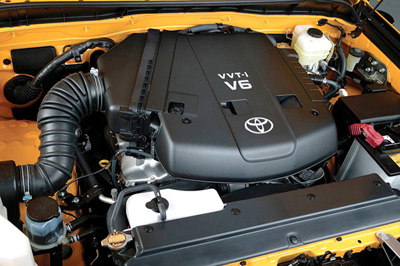
Toyota trucks of the 80’s and early 90’s were not what you would call performers when it came to the engine bay. The recent generation of trucks and SUV’s though has brushed off this label. The 4.0 VVT-I V6 under the hood of the FJ Cruiser does a solid job of shooting this truck down a highway on ramp with its 239 hp and 278ft-lbs. of torque. The performance is helped along with a 5-speed automatic and a smooth shifting 6-speed standard transmission. The high placement of the cold air intake also means confidence in wet water crossings.
Though the new FJ Cruiser bears a slight resemblance to the original FJ-40, under the skin, it’s a completely modern vehicle in every sense of the word. The drive train borrows heavily from the truck and SUV line. The 4-liter 6-cylinder under the hood can be found in the Tacoma truck and other SUV offerings, as are the two transmission options (six speed manual and five speed auto), t-case and rear axle. The suspension consists of a rear solid axle with four links, a pan hard bar and coil springs. Up front you will find an IFS system with rack and pinion steering.
By pushing the wheels to the corners the FJ has good approach and departure angles, but the longer 105-inch wheel base takes a bit of the break-over angle away from an otherwise great wheel base and track width for off road driving. The new FJ shines off-road both inside and out. The best part is there are no buttons to activate the four-wheel drive system – a good old stick is found on the floor!
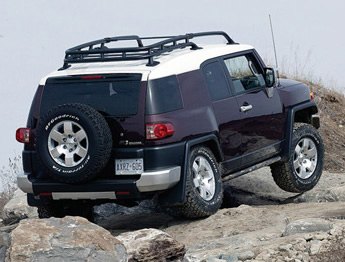
Can modern technology live up to the classic abilities of the FJ nameplate? When comparing a stock FJ-40 to this all-new FJ Cruiser the FJ Cruiser wins hands down. With an excellent off-road traction system called A-trac the FJ Cruiser nimbly takes on rocks with ease. The A-trac system uses braking pressure at the spinning wheel to force traction to the wheels with traction – and it works very well.
That's not enough? What about a full locking rear differential at the push of a button, 32-inch tires stock, a six speed manual transmission, excellent approach and departure angles, off-road skid plating. On the inside – water repellant fabric, easy to clean plastic floors, large controls – and an inclinometer!
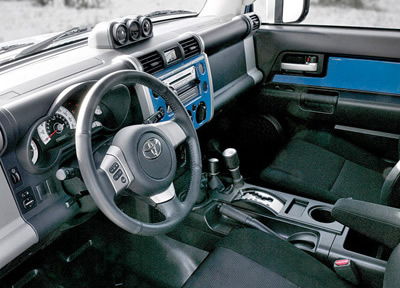
The traction control system includes an A-trac system that uses the vehicle stability control (VSC) system to enhance off-road traction. The VSC system activates the brakes to control wheel spin, which in turn directs the power to the wheels that are planted on the ground. I was surprised at how well this system worked – though the feel of the system as the brakes grab and release the spinning wheels can take a bit to get used to.
The FJ also comes with a rear locking differential. The rear locker is a great addition to an already capable vehicle. It was interesting during our off-road test drive to see that in certain conditions the A-trac system out-performed the rear locker, while in other areas the rear locker worked better than the A-trac. This may be the only vehicle in the market at this time to have such a flexible four wheel drive system that can react to different off-road conditions while keeping the vehicle very driveable on the road.
As well as the previously mentioned Vehicle Stability Control system, the vehicle also comes with anti lock brakes with electronic brake force distribution and an advanced traction control system. This provides all the stability for on road driving and braking control that is found in vehicles much more expensive.
Inside, the FJ is all about utility. Thick plastic covered floors are found in both the passenger and cargo area, a special water repellent fabric covers all the seats while the hard plastic surfaces on the dash, doors and interior panels mean a rugged, easy-to-clean interior – very much like the old FJ40s except without those side-facing jump seats in the back! The large knobs on all the controls will be easy to use even with gloves on. Mounted high on the dash on the C model is a driver control centre, which includes a compass, inclinometer and outside temperature gauge.

The FJ Cruiser, once side-by-side with a FJ-40 gives you a feel of where the heritage of this vehicle came from. The grill with Toyota rather than the symbol now used, the slot in the hood, large side mirrors, square cut front fenders, flat front window, signal light placement – yet it still has its own identity.
The FJ has been designed to mimic a two door. I say mimic as the vehicle is supposed to look like a FJ40. On the new Cruiser there is a pair of suicide doors, which facilitates access to the rear seats. While this door system is far superior to a standard two-door configuration found on other two-door cars and trucks, don’t expect full rear seat access like you’d get with a four-door model. However, with the seats pulled far forward and the rear doors open, riders can slide in and out quite easily. One thing Toyota should think about adding is an automatic slide forward action to the passenger front seat. Currently you need to manually slide the seat forward to get out of the back, and the control can’t be reached by rear seat passengers. Previous Toyotas had this feature as does the Jeep TJ.
 Four door or two door? As you can see with the front seat all the way back you wouldn’t want to stick a full size adult in the back seat for a long drive. Keep in mind though that this is meant to be a two door the addition of the suicide rear doors – once the front seat is slid forwards, offers decent rear seat entry – compared to the FJ of yore and much better than a Jeep TJ.
As this is primarily a two-seater, the focus is on the front seating arrangement and it is well thought out and comfortable. The large front window is kept clean with three – yes, three – wiper blades. This trio of water removers keeps a wide area of window clear. The side windows are large as are the side mirrors, which you will be using to navigate as the large rear pillars beside the back seats take away some shoulder check viewing area.
In the back the rear cargo door opens a full 90 degrees, allowing easy access to a space that is much larger than you would expect from the outside. The big flat floor can haul plenty for a vehicle of this size and the 60/40 split rear seats fold into even more room for your camping gear. I actually prefer the lines of the FJ Cruiser without the roof rack, though the fellow journalists in our group tended to disagree with me. Then again, I have never been known to load the roof of any vehicle I have owned. I think they could have streamlined the rack so it didn’t look like a bunch of ABS pipe glued together, which would also reduce the wind noise. For those that need the cargo space the rack will hold plenty.
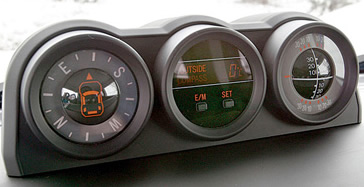 The high mounted driver control pod is only available on the C model (top end). In includes a compass, temp gauge and inclinometer for side hills and descents.
Overall the driving experience in the FJ Cruiser was excellent; lots of power from the 4L six, good shifting points in the automatic, a smooth shifting 6-speed manual and very little body roll for a SUV. If there was a down-side to the ride quality, it was the fact it was a bit stiffer of a ride than what I expected, which some folks may not like. Personally, I prefer this to a soft sedan-like ride – after all, this vehicle was made to be used off-road.
With the retro styling aside, the base price of $29,990 and the loaded C model coming in below $40,000 even with an automatic, the FJ Cruiser will have its legions of followers very shortly.
 The rear cargo area is ready for your camping gear. Durable plastic flooring is found all the way through the FJ Cruiser. In the rear there are lots of tie-downs, hooks, storage compartments and a power plug. Need more room? The rear seats fold flat in a 60/40-split configuration.
As a side note, ARB had already sold 100 bumpers for the FJ Cruiser even though no-one actually possessed an FJ yet as of printing of this magazine – what does that tell you?! Expect ready access to aftermarket lift kits and off-road gear as much of the underpinnings are straight off the Toyota truck shelf and I think aftermarket companies will come fast and furious with gear for these well priced off-roaders.
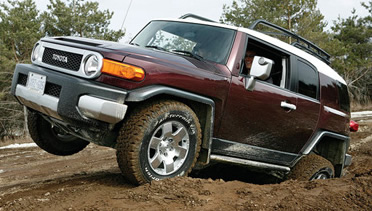 FJ Cruiser, Hummer H-3, Jeep TJ & LJ and Rubicon’s, Hey Ford can you hear this?
 Even events like these need real off-roaders to come off smoothly. In the case of this Toyota event in Ottawa, the Ottawa Valley Off-road club (John Farley at left) oversaw the challenge course and made sure the journalists with little off-road driving experience didn’t get in over their heads.
| 